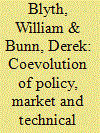| Srl | Item |
| 1 |
ID:
107630


|
|
|
|
|
| Publication |
2011.
|
| Summary/Abstract |
Within the EU, there have been calls for governments to provide greater certainty over carbon prices, even though it is evident that their price risk is not entirely due to policy uncertainty. We develop a stochastic simulation model of price formation in the EU ETS to analyse the coevolution of policy, market and technology risks under different initiatives. The current situation of a weak (20%) overall abatement target motivates various technology-support interventions, elevating policy uncertainty as the major source of carbon price risk. In contrast, taking a firm decision to move to a more stringent 30% cap would leave the EU-ETS price formation driven much more by market forces than by policy risks. This leads to considerations of how much risk mitigation by governments would be appropriate, and how much should be taken as business risk by the market participants.
|
|
|
|
|
|
|
|
|
|
|
|
|
|
|
|
| 2 |
ID:
138919


|
|
|
|
|
| Summary/Abstract |
In 2008, the European Union (EU) decided to include aviation in its Emissions Trading System (ETS) in order to realize emissions reductions in the aviation sector. However, the unilateral measure has triggered strong opposition from various actors, and now, the EU finds itself in the middle of a substantial power struggle about the creation of a global scheme for international aviation emissions reduction. China plays an important role as it has not only banned its airlines from complying with the EU ETS, but also implemented economic retaliatory measures, such as freezing orders of new European Airbus aircraft. Consequently, Beijing could successfully form coalitions with other countries to dilute international negotiations at the International Civil Aviation Organization (ICAO) assembly in 2013. The study reveals the hardships that the establishment of a global carbon emissions reduction scheme for aviation faces. It discusses the leading role of the EU on the issue, and provides a general assessment of possible responses to the aviation directive. It then analyzes China’s position on the inclusion of aviation under a global carbon reduction scheme. Finally, the study provides a prospect on how to overcome the diplomatic struggle in order to achieve concrete carbon emission reductions in aviation. As the study concludes, the EU and the rest of the world would be better off by refraining from unilateral mitigation measures and emphasizing more involvement, engagement, and capacity building in negotiating a possible carbon reduction scheme at the international level.
|
|
|
|
|
|
|
|
|
|
|
|
|
|
|
|